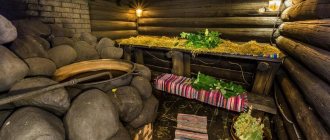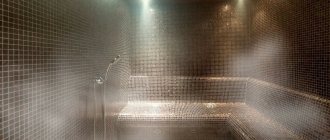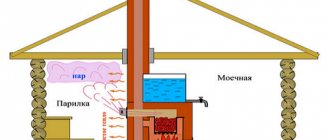Since ancient times, bath procedures have been considered a panacea for many ailments. Doctors actively recommend that patients visit a steam bath to improve their health and strengthen their body. In addition, historically, the bathhouse was a sacred place where children were given birth and baptized, met with friends and had intimate conversations. It is still customary to carry out Christmas rituals in Russian bathhouses.
In modern life, the Finnish sauna competes with the Russian bath. What is the difference between these bath procedures? Why does someone prefer wet or dry steam, how does the body react to a sauna and steam bath? And what's better?
How baths and saunas were built
It is worth noting that today in Scandinavian countries it is difficult to find a free-standing sauna structure. Steam rooms are located in the bathroom of a cottage or apartment. Only in Finland has the tradition of building a bathhouse been preserved separately, on the shore of a reservoir. In addition, similarities with the Russian bathhouse can be seen in the presence of a steam room, a room for ablution and a place for relaxation. It is better that the bathhouse offers a beautiful view, which is pleasant to admire after the steam room.
For your information! Historically, in the Finnish sauna, men and women washed together. In Rus' this was considered a violation of generally accepted morality.
The Russian bathhouse is traditionally a log house made of coniferous wood. The interior of our bathhouse is lined with alder, birch or linden. All bath utensils and furniture are also made of wood.
The Finnish sauna is almost the same in architecture. The main difference is the special design of the sauna stove, which produces dry, intense heat. Therefore, a Finnish sauna has low humidity and high temperature.
Bath procedures can be done “white” or “black”. The difference lies in the presence of exhaust pipes in the furnace. The “white” sauna takes three to four hours to heat up; the heat is created by splashing water on the hot stove. In a “black” sauna, smoke fills the room and warms it up, gradually escaping into a hole in the wall. Warming up in this way requires a lot of wood and more time. The Finnish sauna was originally heated “black”.
Today, wood stoves have replaced modern electrical appliances, so a sauna can be installed in an apartment. Statistics show that every second apartment and house in Finland has a sauna. The Russians have not yet broken this record, but the bathhouse, one way or another, is present in the life of almost every Russian.
Historical essays
The Russian steam room has long been considered a healing remedy that saves from diseases.
Adults regularly visited the steam room and included their children in it. The ancestors considered the bathhouse a place filled with magical properties. When visiting the steam room, various rituals and fortune telling were performed. Often, in conditions of high temperatures, new residents of villages and villages were born. It was impossible to find a cleaner place.
https://www.youtube.com/watch?v=1GgyhdS5YQ0
The first steam rooms were rooms black with soot. At that time chimneys were not built; many people died in the fumes. For this purpose, heaters began to be made. After this, the smoke stopped coming into the room and went straight out into the chimney. Until now, many owners of steam rooms use this type of heating.
For the peoples of Finland, visiting a steam room is considered an integral part of culture. There is no Finn who would refuse pleasant steam treatments. Previously, Finnish steam rooms were heated without the use of a stove or chimney. Then the stoves began to be heated with open heaters, which led to many deaths from carbon monoxide, since many steam room owners did not follow safety precautions. Nowadays, almost all saunas have electric prototypes of stoves.
Are you warm, girl?
The Finnish sauna and the Russian bath have a fundamental difference in the use of dry and wet steam. The thermometer in the sauna can rise to one hundred and thirty degrees. The minimum temperature in a sauna is ninety degrees. At the same time, air humidity does not exceed eight percent. If it were higher, a person’s respiratory tract could suffer serious burns. In such extreme heat, active sweating occurs.
In the Russian version of the steam room, the air temperature does not exceed seventy degrees, and the humidity reaches seventy percent. Humid air warms up better and transfers heat to a person. Such mild conditions contribute to the comfortable healing of the body in the bathhouse.
About the effect of a steam room on the body
The main task of a steam room in a bathhouse is to warm up the human body so as to cleanse it of toxins and waste. All harmful components come out during active sweating through the pores of the skin.
However, extremely high temperatures can lead to tissue shock. That is why the milder conditions of a Russian bath are better than the extreme effects of a Finnish sauna. Humidity in a Russian bath ranges from forty to seventy percent. In combination with the “tolerable” heat, the bath gradually warms up the body without provoking vascular spasms or arrhythmias. These conditions allow even people suffering from high blood pressure and heart problems to receive health treatments. The Russian bath helps with respiratory diseases, increases the vital capacity of the lungs and restores the mucous membrane.
The dry steam of a Finnish sauna also has its advantages. In a stressful situation, the body's systems are mobilized and increased sweating begins. The sauna maintains a stable temperature and humidity. However, visiting a Finnish steam sauna is not recommended for patients with poor health. Hot, dry air can cause severe coughing and dry mucous membranes.
The sauna and its dry heat are excellent for treating diseases of the genitourinary system, liver problems, pyelonephritis, skin diseases and colds. The Finnish sauna is contraindicated for tuberculosis, hypertension, lung disease and nervous disorders.
Ventilation system
In the steam room, it is necessary to constantly maintain the same level of temperature and humidity. For a comfortable, safe stay, a reliable ventilation system must be installed.
Optimal conditions in the Finnish steam room can only be achieved with the correct ratio of air pressure inside the steam room and atmospheric influences outside it.
Russian steam rooms operate on a different principle. Increased pressure is created inside the steam room, since otherwise it is difficult to achieve a high level of humidity. If such conditions are not provided, the bathhouse becomes identical to the sauna, and the entire effect of visiting it disappears.
The process of steam formation in sauna stoves occurs in a closed compartment of the stove unit. Part of the generated thermal energy remains inside the furnace, creating increased pressure. The rest of the mass fills the steam room. Hot air particles rise to the ceiling, while less heated ones remain in the lower part of the room.
Doctors recommend, for preventive purposes, to lie in a steam room so that the body is located in a uniform temperature regime. To ensure uniform heat distribution throughout the room, caring owners provide reliable ventilation.
Ventilation in the sauna
Stove is different
In the stove of a Russian bath, the stones are located in the firebox, which is closed by a door. If you need to increase the temperature in the steam room, open the door slightly and spray water on the hot minerals. The water immediately turns into steam, without allowing the stones to cool. The hotter the stones are, the more active the evaporation of moisture.
The stones in a Finnish stove are located on top. They give off heat to the room. Therefore, the steam is dry and strong. Water is not poured on the stones in a Finnish sauna. The oven itself is much smaller in size than the Russian one.
For your information! Healthy steam - light. In a Russian bath, he immediately lowers himself with the help of brooms and special fans. By the way, releasing steam using bath brooms is considered the “Tatar” way.
Pool or ice hole
A swimming pool is one of the indispensable attributes of a Finnish sauna. To harden the body, a sharp change from the hot heat of the steam room to the coolness of the water in the pool is useful.
There are no pools in a Russian bathhouse, but traditionally bathhouses are installed near natural reservoirs. Swimming in an ice hole after a steam room is the calling card of a Russian bath. In this case, the change in temperature is more extreme, gives much more pleasure and adds adrenaline.
The choice between a Russian bath and a Finnish sauna is everyone’s business. It largely depends on your state of health. The Russian bath has an advantage over the sauna in matters of healing the body, but it is worth recognizing that bathing procedures in the sauna are now more accessible thanks to modern heating devices that can be installed even in an apartment. But can a sauna procedure compare with the fragrant steam and hot broom of a real Russian bathhouse?
- DIY chimney cleaning
- Do-it-yourself home mini sauna in an apartment
- How to dry the basement and cellar from dampness
- How to remove mold from an apartment
Broom in a Russian bath
The use of a broom is one of the main differences between a Russian bathhouse and a Finnish sauna. What could be better than the aroma of oak branches and a therapeutic massage with hot branches? Patting the body with a broom is not just a massage procedure; the beneficial substances of the plant penetrate into the tissues and muscles, strengthening and healing them. The therapeutic effect depends on the material from which the broom is made:
- Birch. Tannins and flavonoids get under the skin from its branches and leaves. The phrase “bath leaf” refers to birch. The leaves of such a broom really stick to the skin better, absorbing toxins and waste released by the body. Taking a steam bath in a Russian bath with a birch broom is useful for people with respiratory diseases and heavy smokers.
- Oak. When exposed to hot steam, it releases a lot of tannins. They have a beneficial effect on the skin and are useful for people with skin diseases. Oak leaf has an anti-inflammatory effect. In addition, oak bark phytoncides strengthen blood vessels and have a beneficial effect on the nervous system.
- Currant. A bath broom is made from young shoots of a currant bush. Currant leaf helps with flu and colds, inflammatory processes in the nasopharynx, and severe cough.
- Nettle. A nettle broom is suitable only for the most determined and persistent. This plant contains large amounts of formic acid. Whisking with such a broom in a hot bath
- Fir, spruce, cedar. Coniferous broom heals wounds, acts as a pro-inflammatory agent and helps with congestive cough. In addition, massage with pine branches stimulates the nervous system and improves mood.
In addition to the listed plants, juniper, branches of linden, bird cherry, ash, rowan, eucalyptus, wormwood, and maple are used for bath brooms. It is better to use combined brooms that combine the beneficial properties of different plants.
In the Finnish sauna they do not use brooms. With dry steam, the broom foliage crumbles. Some amateurs use a broom in the dressing room of a Finnish sauna, but the effect is not at all the same.
Similarities
The sauna from Finland and the bathhouse from Russia are useful places that provide pleasant steam treatments. Moist or dry air contributes to:
- Complete relaxation of the body. Muscles are relieved of tension.
- Relief from fatigue and stress. Good spirits and vitality return.
- Steaming the skin. The pores open, allowing toxins and impurities to come out.
- Accelerates blood microcirculation. The replenishment of organs and individual parts of the body is more intense.
- Removing excess fluid from the body. Steam rooms are recommended for girls who want to lose weight.
- Skin rejuvenation. The epithelium tightens, becomes more elastic, elastic. After several regular sessions, the “orange peel” appearance decreases.
- Hardening the body.
- Strengthening the immune system.
Steam rooms from Finland and Russia cannot be equated. There are certainly many similarities between them, but there are also plenty of differences. Where to go to relax, everyone must decide for themselves. It is important that visiting the steam room is a pleasure, not a discomfort.
Tags: bathhouse, what, Russian, Finnish, good
« Previous entry











